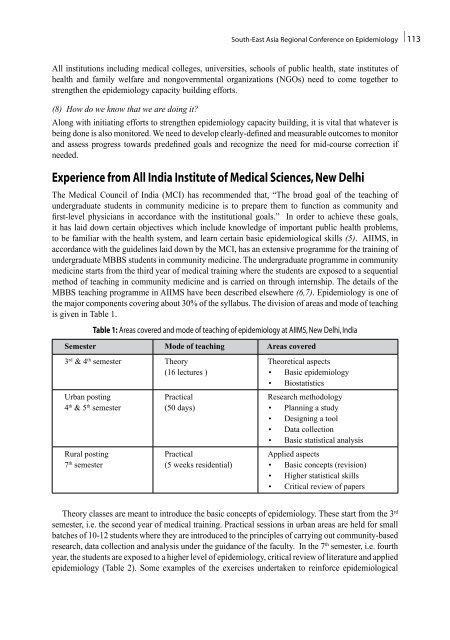South-East Asia Regional Conference on Epidemiology
South-East Asia Regional Conference on Epidemiology
South-East Asia Regional Conference on Epidemiology
You also want an ePaper? Increase the reach of your titles
YUMPU automatically turns print PDFs into web optimized ePapers that Google loves.
<str<strong>on</strong>g>South</str<strong>on</strong>g>-<str<strong>on</strong>g>East</str<strong>on</strong>g> <str<strong>on</strong>g>Asia</str<strong>on</strong>g> <str<strong>on</strong>g>Regi<strong>on</strong>al</str<strong>on</strong>g> <str<strong>on</strong>g>C<strong>on</strong>ference</str<strong>on</strong>g> <strong>on</strong> <strong>Epidemiology</strong> | 113<br />
All instituti<strong>on</strong>s including medical colleges, universities, schools of public health, state institutes of<br />
health and family welfare and n<strong>on</strong>governmental organizati<strong>on</strong>s (NGOs) need to come together to<br />
strengthen the epidemiology capacity building efforts.<br />
(8) How do we know that we are doing it?<br />
Al<strong>on</strong>g with initiating efforts to strengthen epidemiology capacity building, it is vital that whatever is<br />
being d<strong>on</strong>e is also m<strong>on</strong>itored. We need to develop clearly-defined and measurable outcomes to m<strong>on</strong>itor<br />
and assess progress towards predefined goals and recognize the need for mid-course correcti<strong>on</strong> if<br />
needed.<br />
Experience from All India Institute of Medical Sciences, New Delhi<br />
The Medical Council of India (MCI) has recommended that, “The broad goal of the teaching of<br />
undergraduate students in community medicine is to prepare them to functi<strong>on</strong> as community and<br />
first-level physicians in accordance with the instituti<strong>on</strong>al goals.” In order to achieve these goals,<br />
it has laid down certain objectives which include knowledge of important public health problems,<br />
to be familiar with the health system, and learn certain basic epidemiological skills (5). AIIMS, in<br />
accordance with the guidelines laid down by the MCI, has an extensive programme for the training of<br />
undergraduate MBBS students in community medicine. The undergraduate programme in community<br />
medicine starts from the third year of medical training where the students are exposed to a sequential<br />
method of teaching in community medicine and is carried <strong>on</strong> through internship. The details of the<br />
MBBS teaching programme in AIIMS have been described elsewhere (6,7). <strong>Epidemiology</strong> is <strong>on</strong>e of<br />
the major comp<strong>on</strong>ents covering about 30% of the syllabus. The divisi<strong>on</strong> of areas and mode of teaching<br />
is given in Table 1.<br />
Table 1: Areas covered and mode of teaching of epidemiology at AIIMS, New Delhi, India<br />
Semester Mode of teaching Areas covered<br />
3 rd & 4 th semester Theory<br />
(16 lectures )<br />
Urban posting<br />
4 th & 5 th semester<br />
Rural posting<br />
7 th semester<br />
Practical<br />
(50 days)<br />
Practical<br />
(5 weeks residential)<br />
Theoretical aspects<br />
• Basic epidemiology<br />
• Biostatistics<br />
Research methodology<br />
• Planning a study<br />
• Designing a tool<br />
• Data collecti<strong>on</strong><br />
• Basic statistical analysis<br />
Applied aspects<br />
• Basic c<strong>on</strong>cepts (revisi<strong>on</strong>)<br />
• Higher statistical skills<br />
• Critical review of papers<br />
Theory classes are meant to introduce the basic c<strong>on</strong>cepts of epidemiology. These start from the 3 rd<br />
semester, i.e. the sec<strong>on</strong>d year of medical training. Practical sessi<strong>on</strong>s in urban areas are held for small<br />
batches of 10-12 students where they are introduced to the principles of carrying out community-based<br />
research, data collecti<strong>on</strong> and analysis under the guidance of the faculty. In the 7 th semester, i.e. fourth<br />
year, the students are exposed to a higher level of epidemiology, critical review of literature and applied<br />
epidemiology (Table 2). Some examples of the exercises undertaken to reinforce epidemiological









